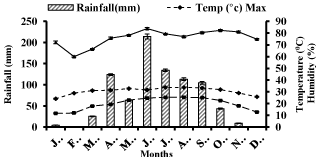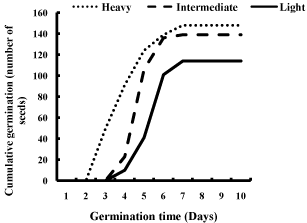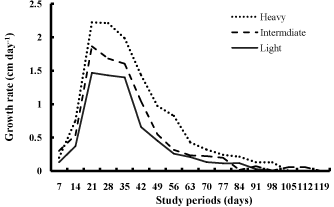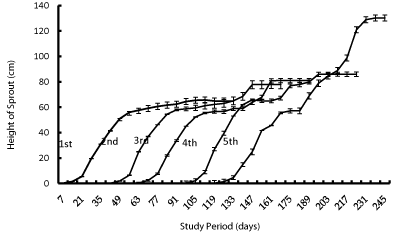
Research Article
J Plant Chem and Ecophysiol. 2016; 1(1): 1003.
Effect of Fruit Mass on Germination and Seedling Characteristics of a Tropical Climbing Bamboo Melocalamus compactiflorus (Kurz) Benth
Das MC, Nath AJ*, Singnar P and Das AK
Department of Ecology and Environmental Science, Assam University Silchar, India
*Corresponding author: Arun Jyoti Nath, Department of Ecology and Environmental Science, Assam University, Silchar, Assam, India
Received: February 02, 2016; Accepted: March 22, 2016; Published: March 24, 2016
Abstract
Fruit mass plays an important role in germination and establishment of bamboo species in forest ecosystems. Melocalamus compactiflorus (Kurz) Benth, a tropical climbing bamboo naturally distributed in forests of North East India (NEI) flowered gregariously, set seed and died in 2011-2012. The reported flowering cycle of the species is ~45 yrs. Therefore, present study is an opportunity to explore: (i) effect of fruit mass on germination and growth of seedlings, and (ii) effect of fruit age on viability and germination. Study revealed negative correlation between fruit mass and germination time (r=0.65; p<0.05; N=300). Statistically positive significant effect of fruit mass on seedling survival and seedling attributes (mean seedling height, diameter of seedling, total leaf number and leaf area) was observed. Increase in fruit age decreased the moisture content, germination rate (%), Mean Germination Time (MGT) and Seed Vigour Index (SVI) of the seedlings. Present study suggests heavy weight fruits promote germination rate and therefore set-in-motion for successful establishment of regenerating stands.
Keywords: Climbing bamboo; Germination; Mean germination time; Seed vigour index; Seed mass; Regeneration
Introduction
Seed mass within a species is considered to be a remarkably perpetual characteristic [1,2]. However, studies indicate variation in seed size and weight within the species [3-5]. Such seed weight variation may affect seedling characteristics and, thus, recruitment process [2,6]. Large sized seeds germinate faster and in higher numbers than smaller seeds [7]. However, a reversed situation was also reported where small seeds germinated more rapidly than large seeds, may be, to gain a competitive advantage [8]. It seems that relationship between seed mass and germination rate is restricted to species level and is not governed by any rule. Empirical studies have shown that seed size can affect seedling survival, growth and establishment [9-12]. Over the past years, many investigators studied relationships between seed mass, germination rate and seedling vigor for different herb, shrub and tree species but it remained unexplored for any bamboo species. Generally bamboo produces one-seeded fruits with thin pericarp adnate to the seed coat, known as caryopsis [13] and such fruit or caryopsis differ morphologically and anatomically from any woody tree seeds [14]. Therefore, it is important to examine fruit behavior of bamboo species in relation to germination rate. In the present investigation, we took the advantage of gregarious flowering and mast seeding of a tropical climbing bamboo to investigate relationship of fruit mass and germination of Melocalamus compactiflorus (Kurz) Benth.
Characteristics of different generations sprout (ramet) of a seedling vary within the regeneration phase. Their survival period and growth completion period plays a key role in establishment of regenerated seedlings [4,15-17]. Unusual flowering behaviour, long and irregular inter seeding period raises concern about bamboo propagation through seeds [14,18-21]. Moreover, flowering and seed production in bamboo is rare and the flowering cycle ranges from 3-120 years [14,18,21,22]. Although bamboo produces abundant seeds through mass flowering [18,22], but, due to the unusual flowering habit planting stocks faces the risk of synchronous flowering [17- 20]. Propagation through seed is very important because it maintains genetic diversity within population [23] and the scientific knowledge of the morphology, germination and longevity of bamboo fruits promotes their better utilization at the time of availability [24,25]. Melocalamus compactiflorus (Kurz) Benth, flowered gregariously in 2011-2012, after 45 years of long vegetative growth [26], and due to long seed setting period, few, if any, attempts have been made to explore the fruits and seedling characteristics. Therefore, present paper specifically aims to describe (i) effect of fruit weight on germination and growth of seedlings, and (ii) effect of fruit age on viability and germination.
Materials and Methods
Study species
Melocalamus compactiflorus (Kurz) Benth locally ‘loti bamboo’ is a semelparous tropical climbing bamboo, sparsely distributed in forest tracts of Barak Valley, Assam. The species naturally grows on other trees in liana like fashion and prefers fringes of perennial streams in semievergreen and evergreen forests of heavy rainfall areas [13,26]. Culms are climbing in nature, base portion of culm is solid, grayish-green, culms and branches bending and scattering over the host tall trees, 15-45 m tall, and 2-4.5 cm in diameter. Branching starts from 5th to 6th nodes of the main Culm. The seeds are caryopsis with fleshy pericarp, semicircular 1.5-3.5 cm long, 1.5-3.0 cm diameter, weight of the fresh fruits varies from 1.5-15.0 g.
Study sites
The study was carried out in Inner-line Reserve Forest (IRF) (92°44’075’’ E, 24°36’161’’ N) of Cachar district, Assam, North East India. This tropical climbing bamboo flowered gregariously during 2011-12 in the entire range of IRF [26]. The climate of Cachar district is sub-tropical and humid, with a mean annual rainfall 2,500 mm, the annual average temperature varies from 11.5 °C to 34 °C, mean annual relative humidity of this study site varies from 60 to 84% (Figure 1). The vegetation of the study site is dominated by Palaquium polyanthum, Cynometra polyandra, Sapium baccatum and Ficus sp. etc.

Figure 1: Climatic conditions of study site.
Fruit collection
Mature fruits were collected during the month of March-April 2013 by manually shaking the fruiting culms after spreading a canvas sheet on the ground. Care was taken to collect only freshly fallen fruits. The fruits were packed in jute bags and transported to the laboratory and thoroughly cleaned and stored in jute bags until the start of the experiments.
Selection of fruits
Viable fruits were selected for germination test. For viability test, fruits were soaked in water. Those immersed in water were considered as viable and floated ones as non-viable or affected fruits. Depending on the fruit mass they were categorized into three categories: light (< 5 g), intermediate (5.1-10 g) and heavy (> 10.1 g).
Germination experiment
The germination test was carried out in petriplates on moistened filter paper. The test was carried out taking 100 fruits in each weight category. The number of fruits germinated was counted and recorded daily for one month. When plumule was 3 cm tall, germinated fruits were transplanted in polybags containing forest floor soil, cow dung and sand in the ratio 1:1:1.
Height growth and growth rate of seedlings
For this study, polybags containing seedling were transferred in a well prepared nursery. The seedlings of each weight category were marked with aluminum foil. The height and diameter of seedlings were measured using metallic measuring tape and digital slide calipers. Diameter was noted at the 3rd internodes of the seedling. Total number of leaves per seedling, leaf length and leaf width were also recorded for each seedling. For the maintenance of the moisture of soil and air, water was sprinkled twice daily for the first two months, and once daily for the later period of study.
Growth behavior of different generation sprouts
For this study, the marked sprouts were observed for 24 months. Height increment, diameter of sprouts, regenerated new sprouts in each seedling, development of side branch-lets and growth stunted time were recorded daily.
Fruit longevity
To study the fruit longevity, a total of 720 fruit were sorted out from the collected fruit bank. Of the total fruits (720), (i) 360 were kept under open places (in petriplates), and, (ii) 360 were kept in jute bags filled with sand. At monthly intervals 30 fruits in (i) and (ii) were taken out to determine their moisture content. In addition to that, another 30 fruits from each experiment were studied at monthly interval for their fruit viability and germination time. Mean Germination Time (MGT) and Seed Vigour Index (SVI) were calculated [27].
Data analysis
Statistical analysis of the data was carried out using MS-Excel and SPSS. The normality test of different parameter was carried out using Kolmogorov-Smirnova test. Further, Pearson correlation test was carried out for normally distributed data and Spearman’s Correlation test for non-normal data. Kruskal-Walis [28] test was performed for the estimation of variance non-normal data distribution using SPSS.
Results
Germination and growth behaviour
Highest germination was observed with heavy fruits (95%) followed by intermediate and light fruits (81% and 72%, respectively). Heavy weight fruits germinated faster than intermediate and light fruits (Table 1, Figure 2). A negative correlation between germination time and fruit weight was observed (r=0.655; p<0.05; N=300). Fruit germination started after two days of keeping fruits in petriplates within the moistened filter paper. No fruit germinated after 7 days in all categories of fruits. Seedling height was significantly influenced by fruit weight (H=258.830; p<0.001). Heavy weight fruits showed maximum height (85.44 cm) over intermediate (60.00 cm) and light weight (52.90 cm) (Table 2). Growth rate of the regenerated seedlings varied among different fruit weight categories. Growth rate was high during the first few weeks after transplanting (Figure 3). The fruit weight had positive influence on growth rate but was statistically not significant (H = 0.362; p= 0.834).
Weight classes (g)
N
% of germinated fruits
% of non- germinated fruits
Light
300
72
28
Intermediate
300
81
19
Heavy
300
95
05
Table 1: Summary table of germination of fruits with respect to different weight categories.
Weight classes (g)
Minimum Seedling height (cm)
Maximum seedling height (cm)
Mean seedling height (cm)
Light
0.26 (n=100)
52.90
39.36
Intermediate
0.39 (n=100)
60.00
46.89
Heavy
0.23 (n=100)
85.44
62.13
Table 2: Descriptive statistics of seedling height of different fruit weight categories.

Figure 2: Cumulative germination curve of different weight seeds.

Figure 3: Growth rate of different fruit mass seedling categories.
It took 55 to 63 days to complete growth of first generation sprouts. Average height and diameter of the first generation sprouts were 57 cm and 0.25 cm, respectively (Figure 4, Table 3). After the completion of growth of first generation seedling, in the next growing season second generation seedling started to develop. Within 56 days, second generation sprouts completed their growth (Figure 4). Third and fourth generation sprout developed in the same year as of second generation sprout. Morphological attributes (side branch-lets) were well developed in third and fourth generation seedlings.
Weight classes(g)
Height of seedling(cm)
Diameter of seedling(cm)
Total no. of leaves seedling-1
Leaf size (cm2 leaf-1)
Total no. of culms
Heavy
85.44a ±2.84
0.589a±0.177
10a±0.29
81.94a±2.11
5±0.13
Intermediate
60.00b ±4.50
0.518b ±0.18
8b±0.13
62.66b±2.22
5±0.11
Light
52.90c ±2.66
0.406c ±0.11
7c±0.26
58.22c±2.50
4±0.11
*Different letters are significantly different at p < 0.05 as measured by LSD between seed age.
Table 3: Seedling attributes of different seed weight categories (Mean±SE).

Figure 4: Growth behavior of different sprouts. All generation sprouts
completes their growth within 56-70 days after germination. Height growth in
M. compactiflorus is independent of fruit mass.
Effect of fruit age on moisture content (%), germination (%), Mean Germination Time (MGT) and Seed Vigour Index (SVI)
Increase in fruit age decreased the moisture content of fruits (Table 4). The fruit stored in sand contained high moisture content (10.25%) than those stored in jar in room temperature (5.12%) after six months of fruit storage. The fruits stored at room temperature lost their viability within five months in comparison to six months in sand (Table 5). The MGT increased with fruit age but not statistically significant. The SVI was observed more in fruits stored in sand than those in sealed jar (Table 5).
Generation
of seedling
Height of seedling(cm)
Diameter of seedling (cm)
Total no of leaves seedling-1
Leaf size(cm2 leaf-1)
1
56.58±1.26
0.25±0.02
4±0.35
19.44±1.20
2
80.9±1.79
0.32±0.16
7±0.18
36.3±1.83
3
110.8±0.95
0.406±0.12
9±1.20
54.6±2.46
4
170±0.95
0.589±0.17
13±1.2
102.4±2.80
5
220.8±2.31
0.69±0.27
16±2.3
143.36±2.40
Table 4: Seedling attributes of the different generations of seedling sprouts (Mean±SE).
Age of fruit (months)
Moisture Content (%)
Germination (%)
MGT(days)
SVI
Fruit stored at room temp.
Fruit stored in sand
Fruit stored at room temperature
Fruit stored in sand
Fruit stored at room temp.
Fruit stored in sand
Fruit stored at room temp.
Fruit stored in sand
1
68.52a(±1.80)
78.72a (±1.80)
93.33a
100a
4.32(±0.24)
4.25(±0.25)
18.51a
22.08a
2
57.81b(±2.31)
58.12b(±2.41)
53.3b
73b
6.97(±0.45)
7.29(±0.35)
8.77b
15.40b
3
50.25c(±1.67)
54.94c (±2.75)
40c
60c
8.33(±0.22)
7.90(±0.23)
5.04c
8.22c
4
44.68d(±0.91)
47.69d (±1.78)
30d
46.67d
10.54(±0.31)
10.35(±0.32)
2.90d
3.09d
5
16.72e(±1.73)
28.02e (±2.43)
0.0e
16.67e
0.0
10.54(±0.31)
0.0e
1.91e
6
5.12f(±1.83)
10.25f (±2.80)
0.0
0.0
0.0
0.0
0.0
0.0
*In a column means followed by different letters are significantly different at p < 0.05, as measured by LSD.
Table 5: Effect of fruit age (storage) on the moisture content (%), germination (%), MGT and SVI.
Discussion
Variation in fruit mass within the studied population of M. compactiflorus (Kurz) Benth can be due to differences in growth and development of culms within the clump. Moreover, competition between inflorescences for available nutrients also causes variation in seed size within the same population [23]. The fruits of M. compactiflorus vary in size and mass than other bamboo species [17,29,30]. As observed in the present study, heavy fruits germinate faster resembles with the results from many tropical tree species [31-33]. Shorter seedling emergence in heavy weight fruits (3-4 days) is attributed to the influence of large fruit size. Such relationship has also been reported for other tree species [12]. Differences in fruit mass and subsequently the amount of food resources within it might have caused variations in seedlings [13]. The variation of the seed mass and size can also be due to genetic and environmental differences [34-37]. Few reports suggests, at the time of germination bamboo produce single plumule [15], whereas, in case of M. compactiflorus (Kurz) Benth it was observed that 30% of the seeds produce 2-3 plumule. Such germination characteristics may be an adaptation to establish vegetative cover following synchronous population death. Growth height in the first generation sprouts depends strongly on seed size as initial growth is closely related to the food reserve [12,38]. Growth rate was observed maximum during 4-5 weeks after transplanting in the nursery that gradually declined over the time and stabilizes on 70-80th day. Bamboo culms complete their growth within three months after emergence and their growth rate was highest during first few weeks [39].
The longevity of bamboo fruit varied from species to species [17]. Seed longevity of 30-35 days for Bambusa tulda, 55 days for Dendrocalamus longispathus and 65 days for B. arundinacea var. spinosa has been reported [30]. The seeds when stored in sand showed more longevity than those stored at room temperature in sealed jar. Although longevity of bamboo fruit varied from species to species but they were viable for few months under ordinary storage conditions [17]. For Bambusa arundinacea var. spinosa, B. tulda and Dendrocalamus longispathus, it was found that the fresh fruits germinated better than those stored ones and longevity varied between 30 to 65 days [17]. Similar observations have been made for M. compactiflorus in the present study. Moreover, complete loss of viability within six months of storage under ambient conditions has also been reported in D. strictus [29], B. tulda [40] and D. membranaceus [41]. The viability of M. compactiflorus (Kurz) Benth fruits showed positive correlation with moisture content of fruits. Mean difference of survivability of seedling (after five months of transplanting) is significantly different among the different fruit weight categories (p<0.0001, N=300). Seed vigour determines the level of activity and performance of seed and seed lot during germination and seedling emergence [42]. The seed lot showing higher seed vigour index is considered to be more vigourous [43]. In this study seedling vigor significantly varied among the three different fruit weight categories (p<0.01; N=300) with highest amount under heavy weight.
Conclusion
The data presented in the article supports the following conclusions (i) heavy weight fruits germinate faster and exhibit higher seedling attributes, and (ii) fruit age significantly affect the germination time and fruit vigour. Furthermore, the data generated will enable proper utilization of fruits at the time of their availability. Seedlings succeed through 4/5 generation of seedling before developing into a well-developed culm with its climbing nature. Therefore, seedling appearance and succeeding survival and growth are vital for natural forest restoration. Studies relating to fruit, e.g. selection of desirable characteristics of bamboo for specific uses, genetic variation pattern, determination of seedling establishment, seed dispersion, natural regeneration and factors affecting regeneration need to be investigated.
Acknowledgement
Authors sincerely thank University Grants Commission, New Delhi for partial funding.
References
- Harper JL. Population Biology of Plants. Academic Press, London. 1977.
- Quero JL, Villar R, Maranon T, Zamora R, Poorter L. Seed mass effects in four Mediterranean Quercus species (Fagaceae) growing in contrasting light environments. Am J Bot. 2007; 94: 1795-1803.
- Thompson K. Seed and Seed banks. New Phytologist. 1987; 106: 23-24.
- Kochhar S, Bhag M, Choudhary RG. Population aspect of the phonological behavior of bamboo germplasm. 1988. Pages 51-58 in Bamboos Current Research (edition) I.V. Ramanuja Rao, R. Ganaharan and C. B. Sastry proceedings of the 3rd International Bamboo Workshop, Cochin, India, 14-18 November.
- Susko DJ, Lovett-Doust L. Patterns of seed mass variation and their effects of seedling traits in Alliaria petiolata (Brassicaceae). Am J Bot. 2000; 87: 56-66.
- Kim SH, Choe ZR, Kang JH, Copeland LO, Elis SG. Multiple seed vigour indices to predict field emergence and performance of barley. Seed Science and Technology. 1994; 22: 59-68.
- Norden N, Matthew ID, Antoine C, Gonzalea MA, Garwood NC, Chave J. The relationship between seed mass and mean time to germination for 1037 tree species across fire tropical forests. Functional Ecology. 2008.
- Howell N. The effect of seed size and relative emergence time on fitness in a natural population of impatients Capensis meerb (Balsaminaceae). American Midland Naturalist. 1981; 105: 312-320.
- Howe HF, Richter WM. Effects of seed size on seedling size in Virolasuria mensis; a within and between analysis. Oecologia. 1982; 53: 347-351.
- Winn AA. Ecological and evolutionary consequences of seed size in Prunella vulgaries. Ecology. 1988; 69: 1537-1544.
- Lehtila K, Ehrlen J. Seed size as an indicator of seed quality: a case study of Primula veris. Acta Oecologia. 2005; 28: 207-212.
- Seiwa K. Effects of seed size and emergence time on tree seedling establishment: importance of development constraint. Oecologia. 2000; 123: 208-215.
- Banik RL. Silviculture and Field-Guide to Priority Bamboos of Bangladesh and South Asia. Government of the People’s Republic of Bangladesh, Bangladesh Forest Research Institute, Chittagong. 2000.
- McClure FA. The Bamboos, Smithsonian Institution Press, Washington and London. 1966.
- Anantachote A. Flowering and seed characteristics of bamboos in Thailand. in: Recent Research on Bamboos IVR Rao; R Ganaharan, Cheria B Shastry (eds) The Chinese Academy of Forestry, People’s Republic of China, International Development Research Centre, Canada. 1985; 66-75.
- Azmy HM. Germination and fertilization of Gigantochloa ligulata seedlings. In: Proceedings 4th International Bamboo Workshop on Bamboo in Asia and the Pacific, held at Chiangmai, Thailand, November 27-30, 1991, Food and Agriculture Organization of the United Nations, Rome, Italy. 1994. 120-122.
- Banik RL. Seed germination of some bamboo species. Indian Forester. 1987; 113: 578-588.
- Janzen DH. Why bamboos wait so long to flower? Annual Review of Ecology and Systematics. 1976; 7: 347-391.
- Campbell JJN. Bamboo flowering patterns- A global view with special reference to East Asia. Journal of the American Bamboo Society. 1985; 6: 17-35.
- Guerreiro C. Flowering cycles of woody bamboos native to southern South America. Journal of Plant Research. 2014; 127: 307-317.
- Veller C, Nowak MA, Davis C. Extended flowering intervals of bamboos evolved by discrete multiplication. Ecology Letters. 2015; 18: 653-659.
- Nath AJ, Franklin DC, Lawes MJ, Das MC, Das AK. Impact of culm harvest on seed production in a monocarpic bamboo. Biotropica. 2012; 44: 699-704.
- Harper JL, Lovell PH, Moore KG. The shape and sizes of seeds. Annual Review of Ecology and Systematics. 1970; 1: 327-356.
- Abe Y, Shibata S. Spatial and temporal flowering patterns of the monocarpic dwarf bamboo Sasa veitchii var. hirsuta. Ecological Research. 2012; 27: 625-632.
- Abe Y, Shibata S. Seed germination and seedling establishment of the monocarpic dwarf bamboo Sasa veitchii var. hirsuta. Journal of Forest Research. 2014; 19: 166-173.
- Das MC, Singnar P, Nath AJ, Das AK. Gregarious flowering in a tropical climbing bamboo Melocalamus compactiflorus (Kurz) Benth in Assam. Indian Forester. 2014; 140: 934-935.
- Abdul-Baki AA, Anderson JD. Relationship between decarboxylation of glutamic acid and vigor in soybean seed. Crop Science. 1972; 13: 227- 232.
- Kruskal WH, Wallis WA. Use of Rank in one criterion variance analysis. Journal of the American Statistical Association. 1952; 47: 583-621.
- Gupta BN, Sood OP. Storage of Dendrocalamus strictus nees seed for maintenance of viability and vigour. Indian Forester. 1976; 104: 685-695.
- Thomas TA, Arora RK, Singh R. Genetic wealth of bamboos in India and their conservation. I.V. Ramanuja Rao, R. Ganaharan and C. B. Sastry, editors. In: Bamboos Current Research, proceedings of the 3rd International Bamboo Workshop, Cochin, India. 1990: 29-31.
- Murali KS. Patterns of seed size, germination and seed viability of tropical tree species in Southern India. Biotropica. 1997; 29: 271-279.
- Negi AK, Todaria NP. Effect of seed size and weight on germination pattern and seedling development of some multipurpose tree species of Garhwal Himalya. Indian Forester. 1997; 123: 32-36.
- Khan ML, Shankar U. Effect of seed weight, light regime and substratum microsite on germination and seedling growth of Quercus semiserrata Roxb. Tropical Ecology. 2001; 42: 117-125.
- Schmidt L. Planning and seed collections. Kristen Olsen, editor. In: Guide to handling of tropical and subtropical forest seed. Danida Forest Seed Centre, Humle back Denmark. 2000: 292-293.
- Trupp CR, Carlson IT. Improvement of seedling vigor of smooth brome grass (Bromu sinermis Leyss) by recurrent selection for height seed weight. Crop Science. 1971; 11: 225-228.
- Tripathi RS, Khan ML. Effects of seed weight and microsite characteristics on germination and seedling fitness in two species of Quercus in a subtropical wet hill forest. Oecologia. 1990; 57: 289-296.
- Young TP, Augspurger CK. Ecology and evolution of long-lived semelparous plants. Trends in Ecology and Evolution. 1991; 6: 285-289.
- Wang W, Franklin SB, Ren Y, Oullette JR. Growth of Bamboo Fargesis qinlingensis and regeneration of trees in a mixed hardwood confer forest in the Qinling Mountains, China. Forest Ecology and Management. 2006; 234: 107-115.
- Nath AJ, Das G, Das AK. Population structure and culm production of bamboos under traditional harvest regimes in Assam, North East India. Journal of Bamboo and Rattan. 2004; 5: 91-100.
- Thapliyal RC, Sood OP and Rawat MMS. Effect of Moisture Content and Storage Temperature on the Viability of Bambusa Tulda Seed. The International Tree Crops Journal. 1991; 7: 67-75.
- Rawat MMS, Thapliyal RC. Storage behavior of bamboo (Dendrocalamus membranaceus) seeds. Seed Science and Technology. 2003; 31: 397-403.
- ISTA. Handbook of seed health testing. Section 2 working sheet. Zurich, Switzerland. 1977.
- Abdul-Baki AA, Anderson JD. Vigour determination in Soybean seeds by multiple criteria. Crop Science. 1973; 13: 630-632.